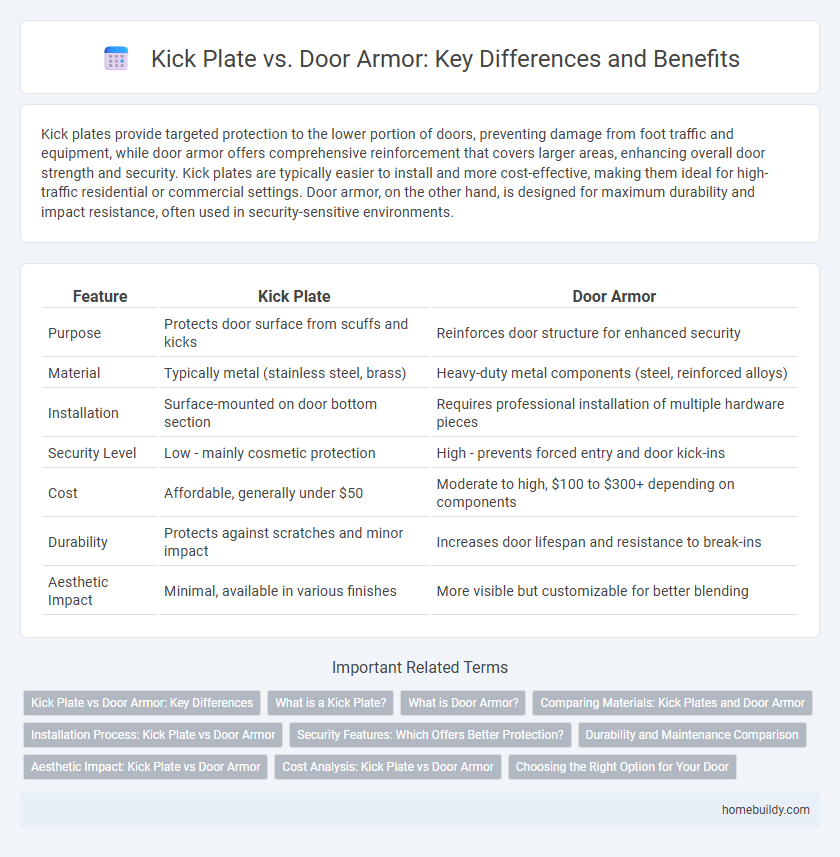Kick plates provide targeted protection to the lower portion of doors, preventing damage from foot traffic and equipment, while door armor offers comprehensive reinforcement that covers larger areas, enhancing overall door strength and security. Kick plates are typically easier to install and more cost-effective, making them ideal for high-traffic residential or commercial settings. Door armor, on the other hand, is designed for maximum durability and impact resistance, often used in security-sensitive environments.
Table of Comparison
| Feature | Kick Plate | Door Armor |
|---|---|---|
| Purpose | Protects door surface from scuffs and kicks | Reinforces door structure for enhanced security |
| Material | Typically metal (stainless steel, brass) | Heavy-duty metal components (steel, reinforced alloys) |
| Installation | Surface-mounted on door bottom section | Requires professional installation of multiple hardware pieces |
| Security Level | Low - mainly cosmetic protection | High - prevents forced entry and door kick-ins |
| Cost | Affordable, generally under $50 | Moderate to high, $100 to $300+ depending on components |
| Durability | Protects against scratches and minor impact | Increases door lifespan and resistance to break-ins |
| Aesthetic Impact | Minimal, available in various finishes | More visible but customizable for better blending |
Kick Plate vs Door Armor: Key Differences
Kick plates are metal or plastic panels installed at the bottom of doors to protect against scuffs and damage from foot traffic, offering a cost-effective solution primarily for low-impact protection. Door armor, in contrast, involves reinforcement systems such as heavy-duty strike plates, wraps, and deadbolts designed to enhance security by preventing forced entry and door frame breakage. While kick plates focus on surface-level protection, door armor provides comprehensive structural reinforcement, making it essential for enhanced door security.
What is a Kick Plate?
A kick plate is a protective metal or plastic panel installed at the bottom of doors to prevent damage from foot traffic, carts, or equipment. Unlike door armor, which offers comprehensive reinforcement around the entire door frame for security and impact resistance, kick plates specifically safeguard the lower portion of the door from scuffs, dents, and wear. These durable plates are commonly used in commercial and high-traffic areas to maintain door appearance and extend lifespan.
What is Door Armor?
Door armor is a robust protective accessory designed to reinforce and shield entry doors from forced entry, scratches, and impact damage. It typically includes heavy-duty materials like steel or aluminum, offering superior resistance compared to standard kick plates. Unlike kick plates that mainly protect the lower door area from scuffs and wear, door armor provides comprehensive security by covering larger portions of the door and reinforcing vulnerable points such as hinges and locks.
Comparing Materials: Kick Plates and Door Armor
Kick plates are typically made from stainless steel, aluminum, or brass, offering durability and resistance to scratches and dents while maintaining a sleek appearance. Door armor often incorporates reinforced metals like steel alloys combined with heavy-duty hardware to provide enhanced security and impact resistance beyond the protection of standard kick plates. Both use corrosion-resistant materials, but door armor prioritizes strength and security whereas kick plates emphasize aesthetic protection against scuffing at door bases.
Installation Process: Kick Plate vs Door Armor
The installation process of kick plates is straightforward, requiring only basic tools like screws and a screwdriver to attach the metal or plastic plate directly to the door's lower section. Door armor installation involves a more complex procedure, often necessitating precise measurements, multiple components such as reinforcing plates and long screws, and sometimes professional assistance to ensure proper alignment and enhanced security. Kick plates primarily protect against scuffs and minor damage, whereas door armor reinforces the entire door structure against forced entry, justifying its more intensive installation process.
Security Features: Which Offers Better Protection?
Kick plates provide basic protection against scuffs and minor impacts, making them suitable for preventing surface damage on doors. Door armor, however, incorporates reinforced materials such as heavy-duty metal and additional locking mechanisms, significantly enhancing resistance against forced entry and break-ins. For superior security, door armor offers a higher level of protection compared to kick plates by addressing both physical reinforcement and intrusion prevention.
Durability and Maintenance Comparison
Kick plates typically offer high durability by protecting door bottoms from scuffs, dents, and damage caused by foot traffic, requiring minimal maintenance with occasional cleaning and tightening. Door armor, designed to reinforce the entire door structure against forced entry, incorporates heavy-duty materials and hardware, resulting in superior durability but often necessitating more frequent inspection and maintenance to ensure proper function. Choosing between kick plates and door armor depends on the desired balance between protective scope, durability needs, and maintenance commitment.
Aesthetic Impact: Kick Plate vs Door Armor
Kick plates offer a sleek and minimalistic aesthetic, seamlessly blending with door designs to provide subtle protection without overpowering the visual appeal. Door armor, while offering more comprehensive security, tends to be bulkier and can significantly alter the door's appearance, often drawing more attention. Choosing between the two depends on the desired balance between visual elegance and the level of physical reinforcement needed.
Cost Analysis: Kick Plate vs Door Armor
Kick plates typically cost between $20 and $100 depending on material and size, offering an affordable solution to prevent door damage. Door armor, including reinforced frames and heavy-duty hardware, ranges from $200 to over $1000, providing comprehensive protection against forced entry but at a significantly higher investment. The cost analysis reveals kick plates are budget-friendly for surface protection, whereas door armor justifies expense with enhanced security and durability.
Choosing the Right Option for Your Door
Kick plates provide targeted protection for the lower portion of doors, preventing damage from scuffs and dents caused by foot traffic and pushing. Door armor offers comprehensive reinforcement, enhancing overall door strength and security against forced entry. Choosing between kick plates and door armor depends on your primary need--surface protection versus full-door security enhancement.
Kick plate vs Door armor Infographic

 homebuildy.com
homebuildy.com